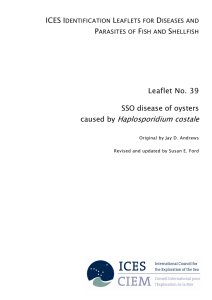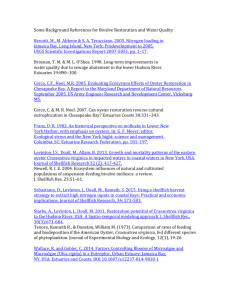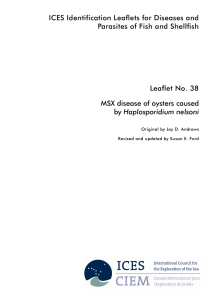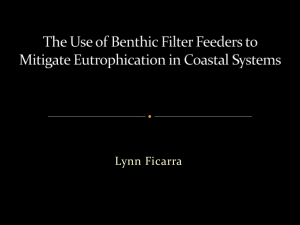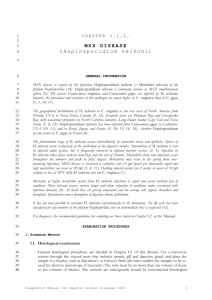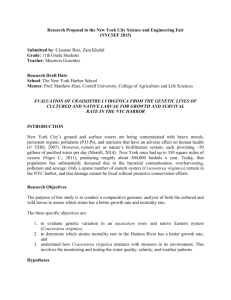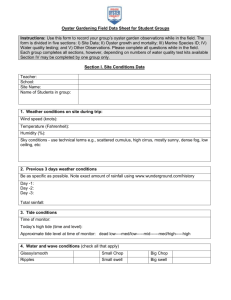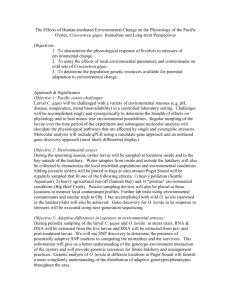3.2.1_SSO - Virginia Institute of Marine Science
advertisement
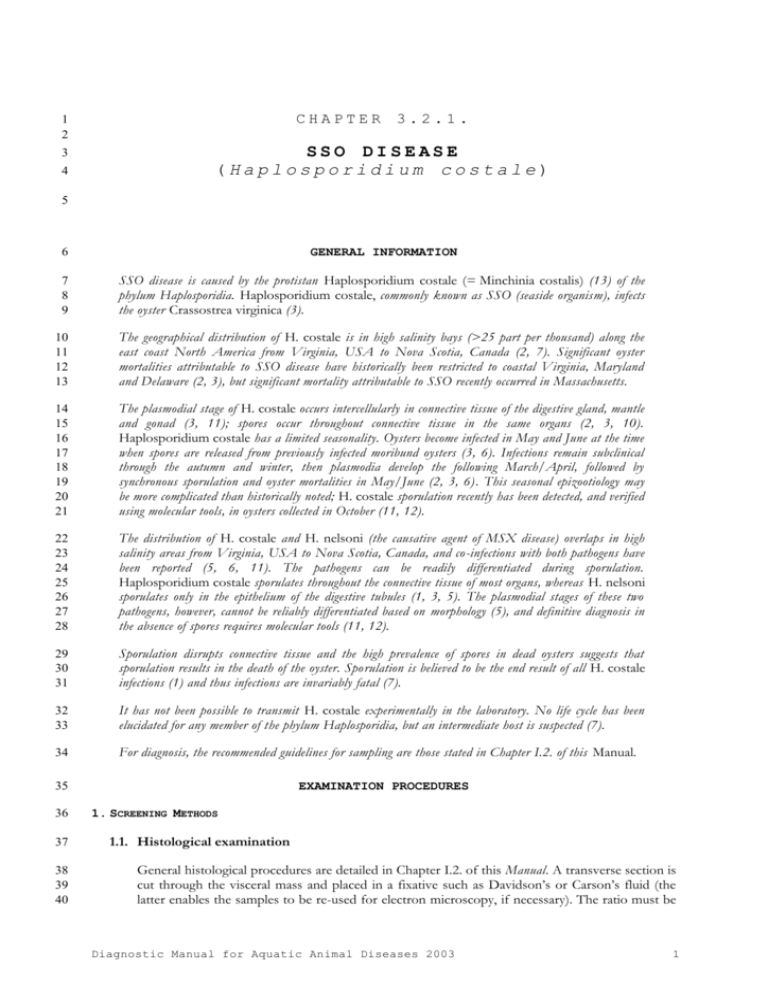
CHAPTER 1 2 3 4 3.2.1. SSO DISEASE (Haplosporidium costale) 5 6 GENERAL INFORMATION 7 8 9 SSO disease is caused by the protistan Haplosporidium costale (= Minchinia costalis) (13) of the phylum Haplosporidia. Haplosporidium costale, commonly known as SSO (seaside organism), infects the oyster Crassostrea virginica (3). 10 11 12 13 The geographical distribution of H. costale is in high salinity bays (>25 part per thousand) along the east coast North America from Virginia, USA to Nova Scotia, Canada (2, 7). Significant oyster mortalities attributable to SSO disease have historically been restricted to coastal Virginia, Maryland and Delaware (2, 3), but significant mortality attributable to SSO recently occurred in Massachusetts. 14 15 16 17 18 19 20 21 The plasmodial stage of H. costale occurs intercellularly in connective tissue of the digestive gland, mantle and gonad (3, 11); spores occur throughout connective tissue in the same organs (2, 3, 10). Haplosporidium costale has a limited seasonality. Oysters become infected in May and June at the time when spores are released from previously infected moribund oysters (3, 6). Infections remain subclinical through the autumn and winter, then plasmodia develop the following March/April, followed by synchronous sporulation and oyster mortalities in May/June (2, 3, 6). This seasonal epizootiology may be more complicated than historically noted; H. costale sporulation recently has been detected, and verified using molecular tools, in oysters collected in October (11, 12). 22 23 24 25 26 27 28 The distribution of H. costale and H. nelsoni (the causative agent of MSX disease) overlaps in high salinity areas from Virginia, USA to Nova Scotia, Canada, and co-infections with both pathogens have been reported (5, 6, 11). The pathogens can be readily differentiated during sporulation. Haplosporidium costale sporulates throughout the connective tissue of most organs, whereas H. nelsoni sporulates only in the epithelium of the digestive tubules (1, 3, 5). The plasmodial stages of these two pathogens, however, cannot be reliably differentiated based on morphology (5), and definitive diagnosis in the absence of spores requires molecular tools (11, 12). 29 30 31 Sporulation disrupts connective tissue and the high prevalence of spores in dead oysters suggests that sporulation results in the death of the oyster. Sporulation is believed to be the end result of all H. costale infections (1) and thus infections are invariably fatal (7). 32 33 It has not been possible to transmit H. costale experimentally in the laboratory. No life cycle has been elucidated for any member of the phylum Haplosporidia, but an intermediate host is suspected (7). 34 For diagnosis, the recommended guidelines for sampling are those stated in Chapter I.2. of this Manual. EXAMINATION PROCEDURES 35 36 37 38 39 40 1. SCREENING METHODS 1.1. Histological examination General histological procedures are detailed in Chapter I.2. of this Manual. A transverse section is cut through the visceral mass and placed in a fixative such as Davidson’s or Carson’s fluid (the latter enables the samples to be re-used for electron microscopy, if necessary). The ratio must be Diagnostic Manual for Aquatic Animal Diseases 2003 1 Chapter 3.2.1. - SSO disease (Haplosporidium costale) 41 42 43 no more than one volume of tissue to ten volumes of fixative. The sections are subsequently treated by conventional histological procedures (4). Haplosporidia are revealed by many nonspecific stains, such as haematoxylin & eosin (H&E). 44 45 46 47 48 49 50 51 52 Multinucleate plasmodia of Haplosporidium costale (usually 5–8 µm in diameter) occur throughout the connective tissue. Plasmodia are only easily detectable between March and June. Synchronous sporulation of H. costale can be observed throughout the connective tissue of the digestive gland, mantle and gonads; sporulation does not occur in the epithelia of the digestive tubules, as seen with H. nelsoni spores (1, 10). Spores (3 5 µm in size) are commonly found in gaping, moribund, oysters. The parasite cannot readily be detected between July and March (1, 3); however, H. costale infections, co-occurring with H. nelsoni, recently have been reported in October (11, 12). Plasmodia of H. costale cannot reliably be distinguished from those of H. nelsoni on the basis of morphology. 53 54 55 56 57 58 59 Infection intensity has been rated (4) as follows: localised (LO) = any infection where plasmodia are localised in a small area of one tissue type; rare (R) = systemic infections with less than ten plasmodia in the entire section; light (L) = systemic infections with less than two plasmodia per field at 400 magnification, but more than ten plasmodia in the entire section; moderate (M) = systemic infections with 2–5 plasmodia per field at 400 magnification; heavy (H) = more than five plasmodia per field at 400 magnification; sporulation (S) = any infection where spores are present. 60 2. PRESUMPTIVE DIAGNOSTIC METHODS 2.1. Histology 61 When spores are present, H. costale can be presumptively diagnosed in the oyster Crassostrea virginica if the spores are the correct size and occur throughout the connective tissue. For detailed histological procedures see Section 1.1. of this Chapter and Chapter I.2. of this Manual. 62 63 64 2.2. Polymerase chain reaction of DNA from oyster tissue 65 66 67 68 A positive polymerase chain reaction (PCR) amplification is only a presumptive diagnosis because it detects DNA and not necessarily a viable pathogen. Other techniques, preferably in-situ hybridisation, must be used to visualise the pathogen. 69 70 71 72 73 74 75 76 77 78 79 80 81 82 83 84 85 86 87 Two sets of PCR primers have been developed for H. costale detection: SSO1358F (5’-TACTGC-TAG-CGC-TTG-TTC-GCA-AGA-T-3’) and SSO1507R (5’-TCG-GGT-CGG-CCC-GCTGAC-TGG-GT-3’) (8) and SSO-A (5’-CAC-GAC-TTT-GGC-AGT-TAG-TTT-TG-3’) and SSO-B (5’-CGA-ACA-AGC-GCT-AGC-AGT-ACA-T-3’) (11). Both of these primer pairs target the small subunit ribosomal DNA and have been shown to be sensitive and specific for this pathogen (8, 11). A multiplex PCR (9) for H. costale and H. nelsoni (MSX) has been developed using the former SSO primers (8), but it has not been validated. PCR reaction mixtures contain reaction buffer (10 mM Tris, pH 8.3; 50 mM KCl; 1.5 mM MgCl2; 10 µg/ml gelatin), 400 µg/ml bovine serum albumin, 25 pmoles each of SSO1358F and SSO1507R or SSO-A and SSO-B, 200 µM each of dATP, dCTP, dGTP, dTTP, 0.6 units AmpliTaq DNA polymerase (Applied Biosystems), and template DNA, in a total volume of 25 µl. The reaction mixtures are cycled in a thermal cycler. The programme for the GeneAmp PCR System 9600 thermal cycler (Applied Biosystems) using SSO-A and SSO-B is: initial denaturation at 94°C for 4 minutes, 35 cycles of 94°C for 30 seconds, 59°C for 30 seconds, and 72°C for 1.5 minutes, and a final extension at 72°C for 5 minutes. The cycle programme is identical using SSO1358F and SSO1507R except that the annealing temperature is 55°C. An aliquot (10% of reaction volume) of each PCR reaction is checked by agarose gel electrophoresis and ethidium bromide staining for the 150 base pairs (bp) amplification product of SSO1358F and SSO1507R or the 557 bp amplification product of SSO-A and SSO-B. 88 2 Diagnostic Manual for Aquatic Animal Diseases 2003 Chapter 3.2.1. – SSO disease (Haplosporidium costale) 89 90 3. CONFIRMATORY IDENTIFICATION OF THE PATHOGEN 3.1. In-situ hybridisation examination of Haplosporidium costale 91 92 93 94 In-situ hybridisation is the method of choice for confirming identification because it allows visualisation of a specific probe hybridised to the target organism. DNA probes must be thoroughly tested for specificity and validated in comparative studies before they can be used for confirmatory identification. 95 96 97 98 99 100 In-situ hybridisation has recently been developed to differentiate plasmodia of H. costale from those of H. nelsoni in tissue sections (11). Species-specific labelled oligonucleotide probes hybridise with the small subunit ribosomal RNA of the parasites. This hybridisation is detected by an antibody conjugate that recognises the labelled probes. Substrate for the antibody conjugate is added, causing a colorimetric reaction that enables visualisation of probe–parasite RNA hybridisations. 101 102 The procedure for the in-situ hybridisation is conducted as follows. Positive and negative controls must be included in the procedure. 103 104 105 106 107 i) Cut a transverse section through the visceral mass that includes mantle, gill and digestive gland and place it in Davidson’s AFA fixative (glycerin [10%], formalin [20%], 95% ethanol [30%], dH2O [30%], glacial acetic acid [10%]) for approximately 24 hours, then transfer to 70% ethanol until processed by histological procedures (step ii). The ratio must be no more than one volume of tissue to ten volumes of fixative. 108 109 110 ii) The samples are subsequently embedded in paraffin by conventional histological procedures. Sections are cut at 5–6 µm and placed on positively-charged slides or 3-aminopropyltriethoxylane-coated slides. Histological sections are then dried overnight in an oven at 40°C. 111 112 113 114 iii) The sections are deparaffinised by immersing them in xylene or another less toxic clearing agent for 10 minutes. The solvent is eliminated by immersion in two successive absolute ethanol baths for 10 minutes each and rehydrated by immersion in an ethanol series. The sections are then washed twice for 5 minutes in phosphate buffered saline (PBS). 115 116 117 iv) The sections are treated with proteinase K, 50 µg/ml in PBS, at 37°C for 15 minutes. The reaction is then stopped by washing the sections in PBS with 0.2% glycine for 5 minutes. The sections are then placed in 2 SSC (standard saline citrate) for 10 minutes. 118 119 120 v) 121 122 123 124 125 126 vi) The prehybridisation solution is then replaced with prehybridisation buffer containing 5 ng/µl of the digoxigenin-labelled oligonucleotide probe. The sequence of the probe designated SSO1318 (11) is 5’-CGA-ACA-AGC-GCT-AGC-AGT-ACA-T-3’. The sections are covered with in-situ hybridisation plastic cover-slips and placed on a heating block at 90°C for 12 minutes. The slides are then cooled on ice for 1 minute before hybridisation overnight at 42°C in a humid chamber. 127 128 129 130 vii) The sections are washed twice for 5 minutes each in 2 SSC at room temperature, twice for 5 minutes each in 1 SSC at room temperature, and twice for 10 minutes each in 0.5 SSC at 42°C. The sections are then placed in Buffer 1 (100 mM Tris, pH 7.5, 150 mM NaCl) for 1–2 minutes. 131 132 133 134 135 136 viii) The sections are placed in Buffer 1 (see step vii) supplemented with 0.3% Triton X-100 and 2% sheep serum for 30 minutes. Anti-digoxigenin alkaline phosphatase antibody conjugate is diluted 1/500 (or according to the manufacturer’s recommendations) in Buffer 1 supplemented with 0.3% Triton X-100 and 1% sheep serum and applied to the tissue sections. The sections are covered with in-situ hybridisation cover-slips and incubated for 3 hours at room temperature in the humid chamber. The sections are prehybridised for 1 hour at 42°C in prehybridisation solution (4 SSC, 50% formamide, 5 Denhardt’s solution, 0.5 mg/ml yeast tRNA, and 0.5 mg/ml heatdenaturated herring sperm DNA). Diagnostic Manual for Aquatic Animal Diseases 2003 3 Chapter 3.2.1. - SSO disease (Haplosporidium costale) 137 138 139 140 141 142 ix) The slides are washed twice in Buffer 1 for 5 minutes each (see step vii) and twice in Buffer 2 (100 mM Tris, pH 9.5, 100 mM NaCl, 50 mM MgCl2) for 5 minutes each. The slides are then placed in colour development solution (337.5 µg/ml nitroblue tetrazolium, 175 µg/ml 5-bromo-4-chloro-3-indolylphosphate p-toluidine salt, 240 µg/ml levamisole in Buffer 2) for 2 hours in the dark. The colour reaction is stopped by washing in TE buffer (10 mM Tris, pH 8.0, 1 mM EDTA [ethylene diamine tetra-acetic acid]). 143 144 145 x) The slides are then rinsed in dH2O. The sections are counterstained with Bismarck Brown Y, rinsed in dH2O, and cover-slips are applied using an aqueous mounting medium. The presence of H. costale is demonstrated by the purple-black labelling of the parasitic cells. REFERENCES 146 147 148 149 1. ANDREWS J.D. (1982). Epizootiology of late summer and fall infections of oysters by Haplosporidium nelsoni, and comparison to annual life cycle of Haplosporidium costalis, a typical haplosporidan. J. Shellfish Res., 2, 15–23. 150 151 152 2. ANDREWS J.D. (1988). Haplosporidium costale disease of oysters. In: Disease Diagnosis and Control in North American Marine Aquaculture, Sindermann C.J. & Lightner D.V., eds. Elsevier, Amsterdam, The Netherlands, 296–299. 153 154 3. ANDREWS J.D. & CASTAGNA M. (1978). Epizootiology of Minchinia costalis in susceptible oysters in seaside bays of Virginia’s eastern shore, 1959–1976. J. Invert. Pathol., 32, 124–138. 155 156 157 4. BURRESON E.M., ROBINSON M.E. & VILLALBA A. (1988). A comparison of paraffin histology and hemolymph analysis for the diagnosis of Haplosporidium nelsoni (MSX) in Crassostrea virginica (Gmelin). J. Shellfish Res., 7, 19–23. 158 159 5. COUCH J.A. (1967). Concurrent haplosporidian infections of the oyster, Crassostrea virginica (Gmelin). J. Parasitol., 53, 248–253. 160 161 6. COUCH J.A. & ROSENFIELD A. (1968). Epizootiology of Minchinia costalis and Minchinia nelsoni in oysters introduced into Chincoteague Bay, Virginia. Proc. Natl. Shellfish. Assoc., 58, 51–59. 162 163 164 7. FORD S.E. & TRIPP M.R. (1996). Diseases and defense mechanisms. In: The Eastern Oyster Crassostrea virginica, Kennedy V.S., Newell R.I.E. & Eble A.F., eds. Maryland Sea Grant College, College Park, Maryland, USA, 581–660. 165 166 8. KO Y.-T., FORD S.E. & FONG D. (1995). Characterization of the small subunit ribosomal RNA gene of the oyster parasite Haplosporidium costale. Molec. Marine Biol. Biotechnol., 4, 236–240. 167 168 169 9. PENNA M.-S., KHAN M. & FRENCH R.A. (2001). Development of a multiplex PCR for the detection of Haplosporidium nelsoni, Haplosporidium costale and Perkinsus marinus in the eastern oyster (Crassostrea virginica, Gmelin, 1791). Molec. Cell. Probes, 15, 385–390. 170 171 10. PERKINS F.O. (1969). Electron microscope studies of sporulation in the oyster pathogen Minchinia costalis (Sporozoa: Haplosporida). J. Parasitol., 55, 897–920. 172 173 174 11. STOKES N.A. & BURRESON E.M. (2001). Differential diagnosis of mixed Haplosporidium costale and Haplosporidium nelsoni infections in the eastern oyster, Crassostrea virginica, using DNA probes. J. Shellfish Res., 20, 207–213. 175 176 177 12. SUNILA I., STOKES N.A., SMOLOWITZ R., KARNEY R. C., & BURRESON E.M. (2002). Haplosporidium costale (Seaside Organism), a parasite of the eastern oyster, is present in Long Island Sound. J. Shellf. Res., 21, 113–118. 4 Diagnostic Manual for Aquatic Animal Diseases 2003 Chapter 3.2.1. – SSO disease (Haplosporidium costale) 178 179 13. WOOD J.L. & ANDREWS J.D. (1962). Haplosporidium costale (Sporozoa) associated with a disease of Virginia oysters. Science, 136, 710–711. 180 181 * * * Diagnostic Manual for Aquatic Animal Diseases 2003 5
